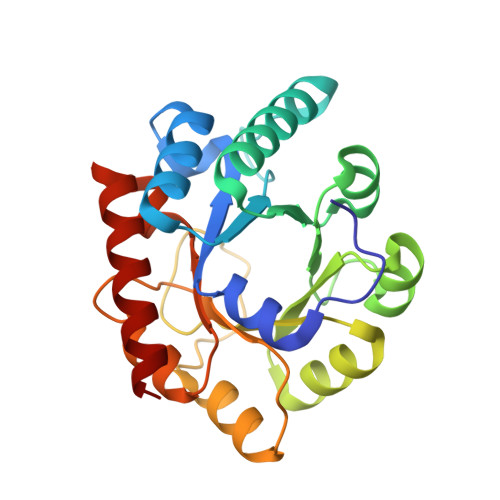Structural characterization of the enzyme-substrate, enzyme-intermediate, and enzyme-product complexes of thiamin phosphate synthase.
Peapus, D.H., Chiu, H.J., Campobasso, N., Reddick, J.J., Begley, T.P., Ealick, S.E.(2001) Biochemistry 40: 10103-10114
- PubMed: 11513589
- DOI: https://doi.org/10.1021/bi0104726
- Primary Citation of Related Structures:
1G4E, 1G4P, 1G4S, 1G4T, 1G67, 1G69, 1G6C - PubMed Abstract:
Thiamin phosphate synthase catalyzes the formation of thiamin phosphate from 4-amino-5-(hydroxymethyl)-2-methylpyrimidine pyrophosphate and 5-(hydroxyethyl)-4-methylthiazole phosphate. Several lines of evidence suggest that the reaction proceeds via a dissociative mechanism. The previously determined crystal structure of thiamin phosphate synthase in complex with the reaction products, thiamin phosphate and magnesium pyrophosphate, provided a view of the active site and suggested a number of additional experiments. We report here seven new crystal structures primarily involving crystals of S130A thiamin phosphate synthase soaked in solutions containing substrates or products. We prepared S130A thiamin phosphate synthase with the intent of characterizing the enzyme-substrate complex. Surprisingly, in three thiamin phosphate synthase structures, the active site density cannot be modeled as either substrates or products. For these structures, the best fit to the electron density is provided by a model that consists of independent pyrimidine, pyrophosphate, and thiazole phosphate fragments, consistent with a carbenium ion intermediate. The resulting carbenium ion is likely to be further stabilized by proton transfer from the pyrimidine amino group to the pyrophosphate to give the pyrimidine iminemethide, which we believe is the species that is observed in the crystal structures.
- Department of Chemistry and Chemical Biology, Cornell University, Ithaca, New York 14853, USA.
Organizational Affiliation:




















